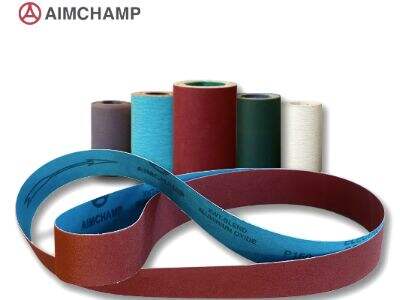सुरक्षित पत्थरहरूलाई फटो बनाउन भन्दा एक वरिष्ठ पद्धति र तिनीहरूलाई एक साथ मज्जागर्न थियो। यो काम बहुत कठिन थियो र यसले बहुत कम समय पनि लाग्छ। हामी आज भाग्यशाली छौं किनकि हामीलाई सैनपेपर छ! सैनपेपर छ Aimchamp अर्को कागज जसको सतहमा चाँडोको टुक्राहरू चिट्टिङग गरिएको छ। चाँडो: यी चाँडोका टुक्राहरू हुन्, जसले खेलको भाषामा सतहहरूलाई फटो बनाउन मदद गर्छ। सैनपेपर केही रुपमा आउँछ र विभिन्न प्रकारका अलग-अलग कामका लागि उपयुक्त छन्। यो प्रवर्णन विभिन्न प्रकारका सैनपेपरहरू, तिनीहरूले के गर्न सक्छन् र तिनीहरूलाई प्रयोग गर्नका बारेमा केही टिप्स दिनेछ।

सैनपेपर घर्षण बुझ्नु
सैनपेपर घर्षण र सँडिङ डिस्क विविध "ग्रिट"हरूसँग उपलब्ध छ। ग्रिट सन्दपेपरको काठमान्डौं बद्दल एक शब्द हो। महत्वपूर्ण छ ग्रिटको नम्बर। यो बढ्दा, सन्दपेपर धेरै सुम्हा पर्दछ। तल्लो सङ्ख्याहरू सन्दपेपरलाई धेर भारी बनाउँछ। अब तपाईंले आफ्नो सतह कसरी तयार गर्ने जान्छ, हामीले विरोधको भागहरू निर्धारण गर्न आवश्यक छ। विरोधको भागहरूमा थोरै ग्रिट वालो सन्दपेपर प्रयोग गर्नु पर्दछ। एउटा नियम छ: यदि पेन्ट वा फिलरलाई स्क्रॅफ कर्न धेरै प्रयास लाग्छ, त्यसपछि 80-ग्रिट वालो बर्तन प्रयोग गर्नुहोस्। यो सक्रिय सन्दपेपर उठाउनका लागि उपयोगी हुन्छ र बाहेकी भागहरू र भारी भागहरू। तर, यदि तपाईंको केही धेरै सुम्हाएका सतहहरू थियो जसलाई थोरै स्क्रब गर्न आवश्यक छ, त्यसपछि अतिरिक्त ग्रिट वालो सन्दपेपर प्रयोग गर्नुहोस्। यो सतहलाई धेरै सुम्हा लगाउन मद्दत गर्दछ।
पिछाड र बिना पिछाडको सन्दपेपरको प्रयोग
कभरै, सन्दपेपर र छात्ता पैड कुनै पनि बाटोलाई backing भन्दै रहेको कुराले संग आउनेछ। एक backing हो, raw tape को प्रकार जसले sandpaper लाई एकत्रित गर्दछ। यो मुख्यतया कागज र कपडाबाट बनेको छ। Backing: Backing महत्वपूर्ण छ किनकि यो sandpaper लाई थप दिन्सो र धेरै सुलभ रूपमा पकड्न मद्दत गर्दछ। जब तपाईं एक समतल सतह जस्तै मेज वा बोर्ड सँड गर्दै हुन्छ, backed sand paper प्रयोग गर्न सुझाव दिइन्छ। यसले तपाईंलाई अनुष्ठान बढाउन मद्दत गर्दछ र यो तपाईंको sandpaper लाई समतल राख्दछ। तर यदि तपाईं एक घुम्ता भाग, उदाहरणका लागि चेयरको पैर, सँड गर्दै हुन्छ, केवल कागज राख्न सबैभन्दा बेहतर हुन सक्छ। यस प्रकारको sandpaper सँड गर्ने क्षेत्रमा बढी सुलभ रूपमा घुम्ता भागहरूमा लागि पर्दछ।
विशेष परियोजनाहरू कागज सँड गर्न विशेष आवश्यकता छ
कभर्दै तपाईंले सतहहरू फेला पार्ने छन् जसले सँड गर्न विरोध गर्दछ र सँडिंग स्पंज . र यसले विशेष सैन्डपेपरहरू प्रवेश गर्दछ! सामग्री, जस्तै मेटल र प्लास्टिक भन्दा धेरै थोरै खट्टा सैन्डपेपरहरू बनाउन सकिन्छ। यी कार्यक्षमता मा उपरि जस्तै हुन्छन् तर यी एक पुरानो फर्निचरमा काम गर्न वा केही नयाँ बनाउन जस्ता विशेष परियोजनामा प्रयोग गर्न सकिन्छ। सैन्डपेपरको प्रकार कारणसहित महत्वपूर्ण छ। सही प्रकार / गलत प्रकार प्रयोग गर्ने रुपमा, तपाईंले आफ्नो काम सतहमा नुकसान पनि गर्न सक्नुहुन्छ। प्रारंभिक तयारी गर्न विचार गर्न अघि तपाईंले आवश्यकता के छ त्यसबारे केही समय खर्च गर्नुहोस्।
अझ थोरै खट्टा ग्रिटहरूसँग सैन्डिङ
तप्पी रूखो सैन्डपेपर प्रयोग गर्नुहुन्छ, तर यसलाई सहि रूपमा गर्न जरुरी छ। यदि तपाईं यसलाई सहि गर्दैनुहुन्छ, तपाईंले लैपटॉपलाई किस्ती बनाएर वा त्यसको भएको सतहलाई चिन्ह बनाउन सम्भवतः हुन सक्छ। तपाईंले पहिले कुरामा आफ्नो लकडीको धाराको साथ थोडा सैन्डिंग गर्नुपर्छ। तपाईंले लकडीमा धाराको साथ काम गर्न चाहनुहुन्छ, मतलब लकडीलाई दिशागत रूपमा सैन्ड गर्नुहोस्। यसले तपाईंलाई सर्वोत्तम परिणाम प्राप्त गर्न मद्दत गर्न सक्छ। यदि तपाईंको पास रूखो ग्रिट सैन्डपेपर छ, त्यसलाई सबैभन्दा पहिलो बार गर्नुहोस् र धीरे-धीरे त्यसको बाटोमा पुग्नुहोस्। तपाईंले बढी दबाव दिनु चाहनुभयो, किनकि बढी दबाव दिन शीर्षको खराब गर्न सक्छ। जब तपाईं आफ्नो ग्रिट चक्रमा काम गरिरहेको छ, रूखो सैन्डपेपरहरूले कम दबाव लागि जरूरी छ, तर जब तपाईं फिन ग्रिटमा पुग्नुहुन्छ, यो थप्पा दबाव (वुडवर्किंगको तकनीकी शब्द LOL) दिशाको अपनो बदलिएको समयमा केही फुलाइ दिन्छ। रहस्य यो हो कि लकडीको धाराको साथ सैन्ड गर्नु हो, तर हरेकदा धाराको दिशामा समाप्त गर्नु हो।
सैन्डपेपर सुरक्षित रूपमा प्रयोग गर्न!
चिरोटी कागज ठीक छ, जब तक यसलाई सुरक्षित ढंगले प्रयोग गरिन्छ। तपाईंले हरेक बार चिरोटी खाल्दा सुरक्षा आँखाको चश्मा र मास्क प्रयोग गर्न चयन गर्नुहोस्। यी तपाईंका आँखा र फेफडालाई धूलको खतरोबाट बचाउनेछ। चिरोटी खाल्ने धूल तपाईंका आँखा झनझना गर्न सक्छ र खाँच्न गर्न सक्छ। एकदमै यो भन्दा बढि चिरोटी कागजलाई हातले प्रयोग गर्नुभएको छैन किनकि यसले तपाईंको हातलाई तेलियो बाँक गर्न सक्छ। यी छोटो छोटो चामला तपाईंको त्वचामा प्रवेश गर्न सक्छ र यसले खराबी वा छात्तो गर्न सक्छ। अन्तिम मा, हरेक बार सुरक्षित क्षेत्रमा चिरोटी खाल्नुहोस् (कुनै राम्रो शब्द थिएन lol,) यसको अर्थ खुला ठाउँमा खाल्नुहोस् तर्फ तपाईंले धूल आसानीसँग साँस लिन सक्नुहुन्छ।

 EN
EN
 AR
AR BG
BG HR
HR CS
CS DA
DA NL
NL FI
FI FR
FR DE
DE EL
EL HI
HI IT
IT JA
JA KO
KO NO
NO PL
PL PT
PT RO
RO RU
RU ES
ES SV
SV TL
TL IW
IW ID
ID SR
SR ET
ET MT
MT TH
TH TR
TR FA
FA AF
AF MS
MS GA
GA CY
CY MK
MK EU
EU KA
KA LA
LA NE
NE